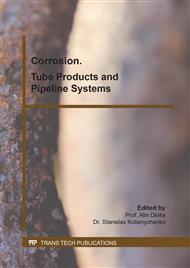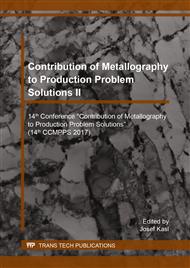p.112
p.118
p.124
p.130
p.136
p.142
p.149
p.156
p.162
Evaluation of Surface Degradation of Deoxidized AW-AlMg0.7Si Alloy
Abstract:
Corrosion of aluminium alloys due to chlorides is not rare in industrial practice. When detected, it is necessary to decide whether and how to remove the corroded areas and also to find the appropriate method for protection against further degradation. Appearance and quality of final surface is key factor in such cases. This study deals with final surface quality of aluminium alloy components and the extent of degradation after corrosion attack and subsequent chemical surface cleaning. Two AW-AlMg0.7Si alloy pipes, fabricated by two individual producers, were analyzed in order to reveal extent of atmospheric corrosion after the storage in the industrial area. Further analysis evaluated the influence of such degradation on final surface quality after surface cleaning by chemical way, using two different methods, namely deoxidizing and subsequent passivation. Special attention was paid to the influence of initial surface roughness on quality of final surface.
Info:
Periodical:
Pages:
136-141
Citation:
Online since:
November 2017
Price:
Сopyright:
© 2017 Trans Tech Publications Ltd. All Rights Reserved
Share:
Citation:



